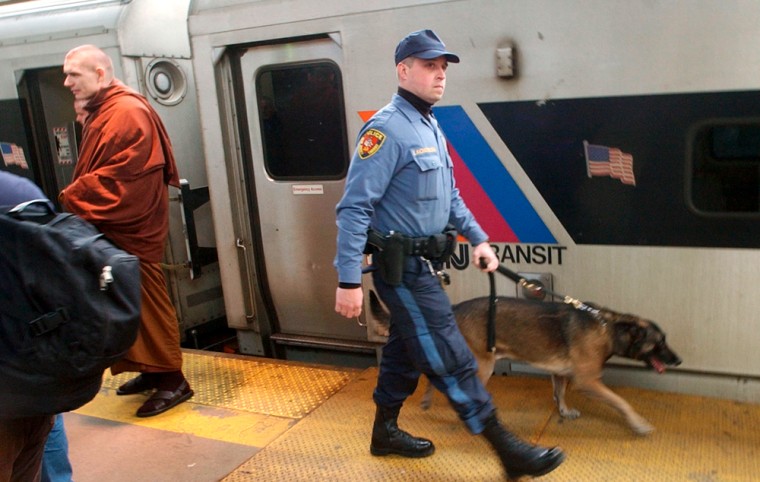The federal government announced several small-scale efforts Monday intended to bolster rail security. The moves are a response to criticisms that the administration hasn’t paid enough attention to transit security, an issue thrust onto the national stage in the aftermath of the commuter train bombing in Madrid.
But Department of Homeland Security Secretary Tom Ridge sought to deflect the notion that his agency has sat idle in the area of rail security, noting that many steps were put in place “immediately” after 9/11.
“Now, many of these initiatives didn't get too much attention, because most of the public discussion about threat reporting has focused on other areas, other sectors, like aviation,” Ridge told reporters. “But the bombings in Madrid are a solemn reminder that terrorists continue to expose and exploit our vulnerabilities.”
Beginning immediately, DHS plans to develop a rapid-response team centered on bomb-sniffing dogs, Ridge said Monday.
“We will use current DHS resources in creating these mobile response teams that will be specially trained to work in the undergrounds and tunnels unique to some transit and rail environments,” Ridge said.
A standardized “best practices” baseline of security measures, drawn from exemplary programs around the nation, also will be adopted, Ridge said, though such standards wouldn’t be federal mandates. Such steps will further solidify security measures for transit systems nationwide as some systems only increase security when the nation moves to “Code Orange” or “high alert” status.
The move could lend a “regulatory effect” to Homeland Security’s interaction with private sector rail facilities, said a Homeland Security official; however, the intent of DHS is “not to micromanage” any segment of the security environment, as Ridge has previously stated.
Aviation security no role model
Transit systems are inherently vulnerable given their necessary openness to passenger access; however “an aviation standard” of security won’t work, Ridge said.
Any new measures for transit systems must balance security while seeking to preserve the flexibility, convenience and easy access that characterize such systems, Ridge noted.
“Clearly, we could provide enough security to put the mass transit systems out of business,” Ridge said. “So trying to find that balance is something that we need to do.”
To help achieve that balance, Ridge said the Transportation Security Administration will implement a pilot program “to test the feasibility of screening luggage and carry-on bags at rail stations and aboard trains.”
The location of the pilot program and the technologies to use in the trial haven’t yet been picked. But the program will look at a variety of “protocols” and procedures, apart from those used in the aviation security model, Ridge said.
No new money
Although billions of dollars has been spent to thwart another terrorist strike using planes and biological or chemical weapons, only $115 million has been spent to bolster rail security. That figure has drawn the ire of lawmakers demanding more federal security dollars be applied to transit systems.
“More security funding should be the first priority, not the third rail, in our efforts to make our public transportation systems safe for passengers,” said Rep. Edward Markey, D-Mass. Markey’s reaction was echoed by several on Capitol Hill last week. Sen. Olympia Snowe, R-Maine, sent Ridge a letter last week noting what she called “disconcerting” discrepancies in how security dollars were spent, with transit systems getting the fewest dollars of all.
But no new money is forthcoming, Ridge said Monday. “There's already money in the pipeline dedicated specifically to some of these purposes, and we think we have enough flexibility in other programs to meet the initial needs,” Ridge said.
Ridge also used Monday’s news conference to highlight the fact that since “immediately after 9/11” steps were taken to increase rail security. The private sector alone, since 9/11, has pumped $1.7 billion into added security measures, Ridge said, citing figures from an industry report.
Vulnerability assessments have been done; joint federal-state and local security exercises have been conducted and DHS is screening high-risk rail cargo entering the United States through the National Targeting Center and through border inspections. These current procedures, Ridge said, are security steps that help keep U.S. transit systems safe, yet “go unseen” by the public.
But the hard fact is that rail security, now and for the foreseeable future, will be a lower priority than aviation or biological or chemical threats, DHS officials say.
“An aircraft can be used as a weapon,” said DHS Undersecretary Asa Hutchinson during an interview on MSNBC. “A train cannot be hurled through the air in the same fashion.”
Additionally, U.S. intelligence sources continue to pick up information that al-Qaida is still interested in trying to use airplanes as weapons. However, no such immediate or planned threats have been noted that target U.S. rail systems, Ridge said Monday.
